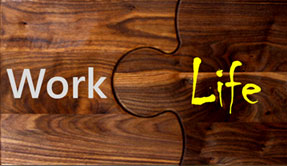Better work-life integration
 If you woke up this morning wondering how to divide your energy between home and work responsibilities, you are in good company. BeWell spoke with Phyllis Stewart Pires, director of WorkLife Strategy at Stanford, about the challenges we all face as we juggle our crazy-busy work and life demands.
If you woke up this morning wondering how to divide your energy between home and work responsibilities, you are in good company. BeWell spoke with Phyllis Stewart Pires, director of WorkLife Strategy at Stanford, about the challenges we all face as we juggle our crazy-busy work and life demands.
Is “work-life balance” still the right term?
I really stopped using the term “balance” when I had my first child. I realized that aspiring to “work-life balance” conjures up an image of equal parts offsetting each other and that you had to take from one part of your life to give to the other. It also creates the illusion that there is this happy, harmonious moment when you can say, “Ah, I’ve got it!”
Real life is much messier than that, so I prefer the term “work-life integration.” Some people prefer “work-life fit.” Both terms conjure up an image of successfully putting things together — life puzzle pieces. When work and life fit together well, and are integrated, people feel successful. The fit is different for each individual, depending on their life circumstances.
How is your work-life integration?
Just this morning, I had a call from my dad’s caregiver, had difficulty getting my daughter off to school on her bike, and received an email reminding me of a forgotten volunteer responsibility. I had to take a few minutes to remind myself that this may not be one of those days when my work-life “fit” feels just right. There are days when it just feels messy, and I have to be OK with that.
Given your job title, that is a brave answer …
I believe the best role models don’t just model how to do something well; rather, they show us how to get through the difficult times, too. Like many people at Stanford, there are a lot of demands on me and I have high expectations for myself.
Who is most impacted by work-life integration issues?
Data indicates that women still carry a larger portion of the “burden” of caregiving for aging parents and children. However, I think there has been a shift, and we should recognize that men and women are both impacted. When things are off kilter, we feel it equally.
Is there a stage of life that is more challenging?
Yes: one of the most stressful stages is when someone is providing an intensive level of care for their parents — when any phone call can be the heart-stopping call about the broken hip or the shut off PG&E bill — coupled with having active school-aged children and a job with a lot of responsibilities.
We all have a strong desire to be successful in all of these areas. You don’t want to let anyone down, which creates a sense of stress and you often wonder: “How do I fit all of this into a day?” So, how do I fit it all into a day?
So, how do I fit it all into a day?
[Laughter] You have to reevaluate your priorities on a daily, sometimes hourly, basis. It is important to keep your sense of humor, keep your personal wits about you and ask yourself, “How can I shift priorities over the course of the day?”
What advice can you offer our readers?
I recently spoke with a group and made these three recommendations:
- Perfection does not have to be the goal. Maybe this is the day you send store-bought cupcakes when everyone else is sending homemade cupcakes. Or, if you are a caregiver to elderly parents or grandparents, there may be a day when you call on the phone instead of visit because you just have too many irons in the fire. Don’t set yourself up to believe you have to do the most complicated and involved effort every single day.
- As a parent, one moment does not define your relationship with your child or your skill as a parent. If you fall apart one morning, which happens to everyone, you can forgive yourself and make amends. Over a lifetime, you get many moments.
- Don’t make enormous decisions when you feel like your hair is on fire. When things are falling apart, it is not the time to decide if you will stay in the workforce or accept that promotion.
… any final thoughts?
There is a tremendous amount of support at Stanford, but that doesn’t necessarily make life simple. Stanford is full of people with high ambitions, ideals and aspirations. We all want to be super good at everything we do. As a result, we have to constantly challenge ourselves to think about how we define our own work-life integration.
Phyllis Stewart Pires designs and manages programs and services that support the Stanford community. The WorkLife Office helps faculty, staff, postdocs, students and retirees navigate the competing demands of work, study, personal, and family lives.
Stanford University WorkLife Office
3160 Porter Drive, Suite 250
(650) 723-2660
Interview conducted by Julie Croteau and edited by Lane McKenna Ryan.
